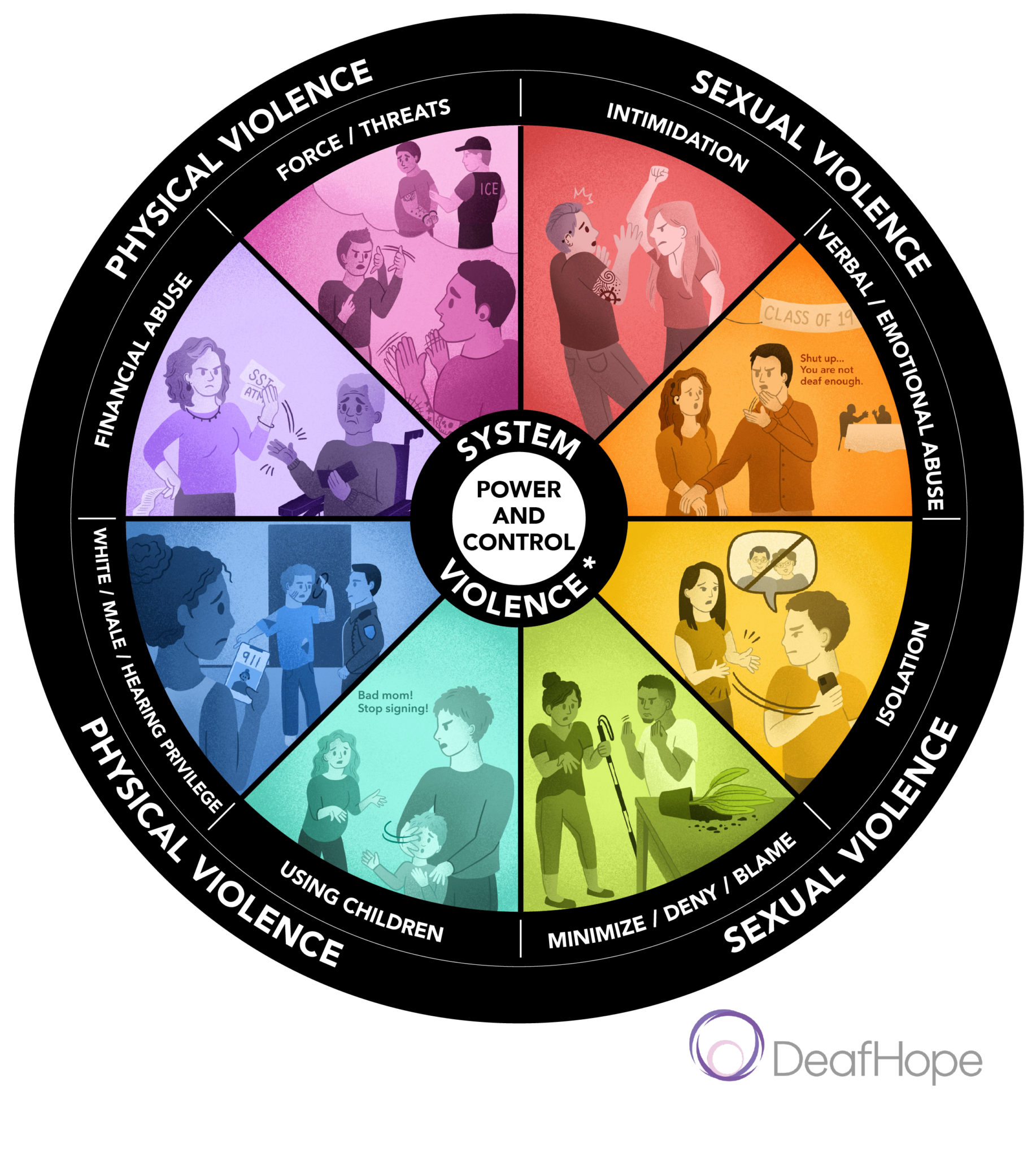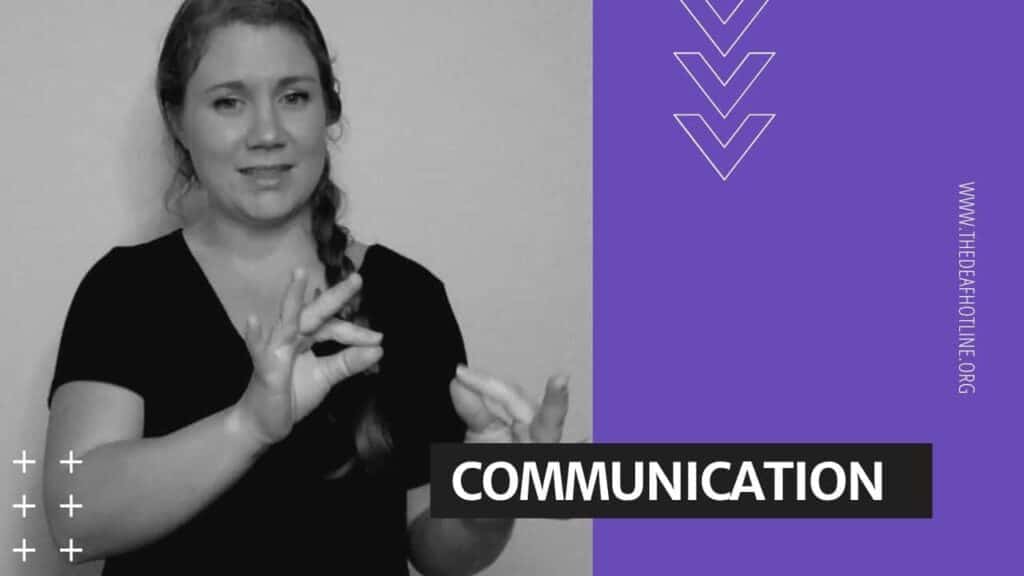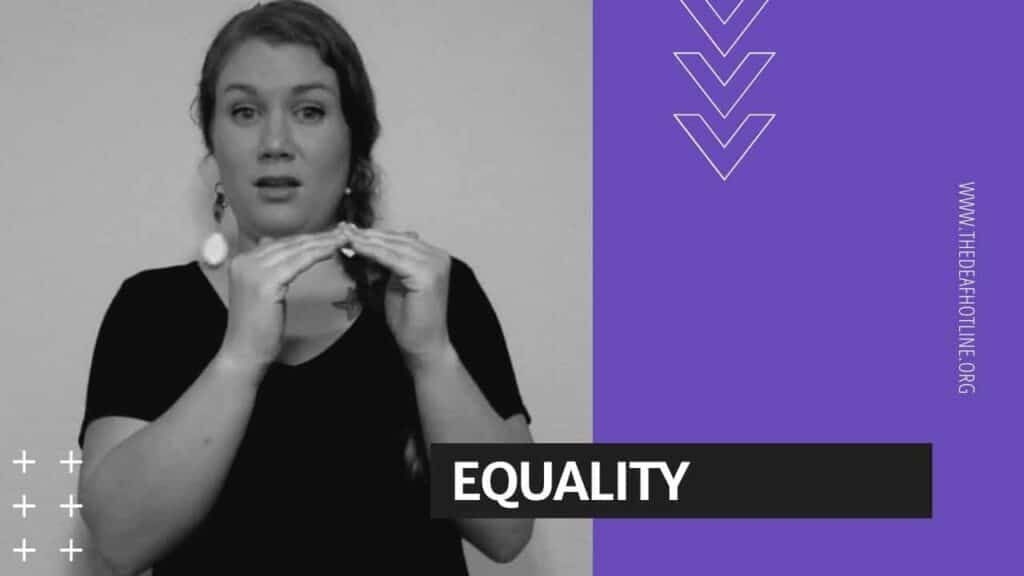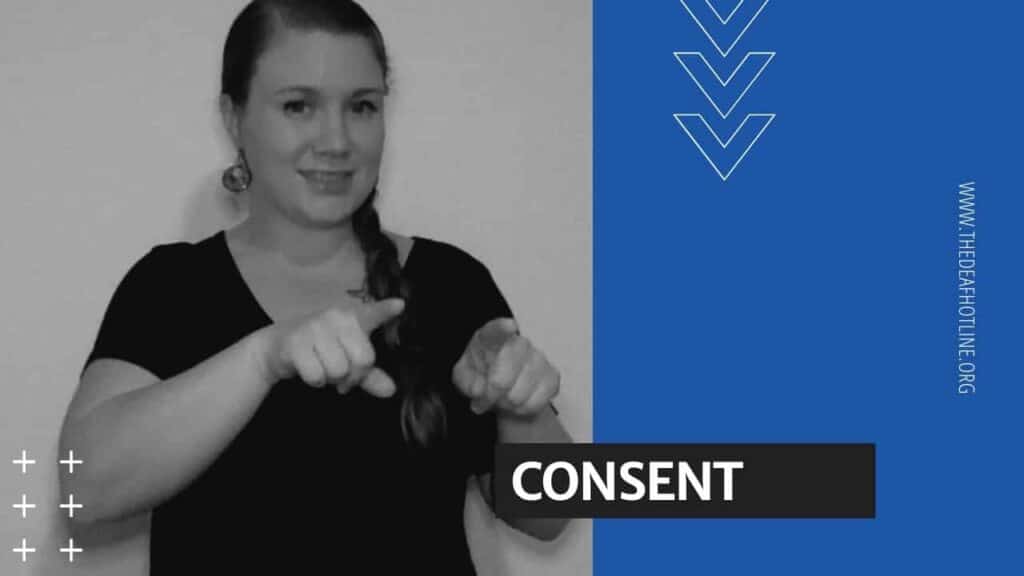
The seed of all abuse is power and control
Why People Abuse: Power and Control
Abusive partners use abuse as a tool to acquire, build, and maintain power and control over their partner. This is why abuse often shows up in many forms. Ending domestic violence (DV) means learning the behaviors that define abuse. DV can also be referred to as intimate partner violence (IPV), dating abuse, or relationship abuse.
People of any race, age, gender, sexuality, ability, religion, education level, or economic status can be a victim or abusive partner.
Abuse encompasses more than just physical violence
The Power and Control Wheel
The Duluth Model is a widely recognized approach for addressing domestic violence and abuse. Its central feature is the Power and Control Wheel, which outlines the various tactics used by abusers to establish and maintain control over their partners. DeafHope's wheel builds on the Duluth Model and provides ASL explanations for each part. The parts on the power and control wheel are, but not limited to:

Intimidation
Intimidation is using threats or fear to control or manipulate a partner.
Isolation
Isolation is a tactic used by abusers to control their victims by limiting their access to friends, family, and resources.
Coercion and Threats
Force involves the use of violence, or the threat of it, to exert power and control over a partner.
Economic Abuse
Economic abuse involves controlling a partner's access to financial resources, which can make it difficult for them to leave the abusive relationship.
Minimize, Deny, Blame
Minimizing is a tactic used by abusers to downplay or deny the seriousness of their abusive behavior and its impact on their partner.
Using Children
Using children is a tactic used by abusers to manipulate and control their, often by threatening harm to the children or using them to relay messages.
Emotional Abuse
Verbal or emotional abuse involves using words or actions to undermine their self-worth, confidence, and mental and emotional well-being.
Modes of Oppression
A tactic used by abusers to maintain power and control over a partner by leveraging societal systems of marginalization.
Unique Circumstances For Deaf Survivors
- Information can travel quickly within the deaf community, compromising confidentiality and the survivor's safety.
- Law enforcement and shelters are often not skilled at communicating with deaf, deafblind or hard of hearing individuals and often don't provide interpreters.
- Their abusive partners may take away their communication devices.
- Their abusive partners may give false information to the survivor to make them believe they have fewer options.
- The survivor may be isolated from family, friends, services, resources and options.
While there may be patterns, abuse is never predictable
Is Abuse A "Cycle"?
At the start of a new relationship, it’s not always easy to tell if it will later become abusive. In fact, many abusive people appear like ideal partners in the beginning of a relationship. Possessive and controlling behaviors don’t always appear overnight and may emerge and intensify as the relationship grows.
Like the National Domestic Violence Hotline writes, “we use many different words when we’re describing abuse: systematic, power, control, pattern, purposeful. One word we don’t use when talking about abusive relationships is cycle.”
The reality is that tactics to gain power and control can come from any direction at any given point as a variety of types of abuse.
Types & Signs of Abuse
Abuse sneaks up on people. It is strategic. We are talking about a pattern of behavior, in other words, not just one incident or form. Before any type of abuse takes place, the goal is to gain power and control. These behaviors can take on different forms and are often used in combination to exert control over their partner.
Signs of Abuse- Pulls your hair, punches, slaps, kicks, bites, or strangles you
- Forbids or prevents you from eating or sleeping
- Uses weapons against you, including firearms, knives, bats, or mace
- Prevents you from contacting emergency services, including medical attention or law enforcement
- Harms your children, loved ones or pets
- Drives recklessly or dangerously with you in the car or abandons you in unfamiliar places
- Forces you to use drugs or alcohol
- Throws objects at you
- Prevents you from taking prescribed medication
- Calls you names, insults you, or constantly criticizes you
- Telling you that you never do anything right
- Acts jealous and possessive or refuses to trust you
- Isolates you from family, friends, or other people in your life
- Humiliates you in any way, especially in front of others
- Threatens you, your children, your family, or your pets
- Damages your belongings, throws objects, or damages walls or doors
- Blames you for their abusive behavior
- Tells you that you're lucky to be with them or that you'll never find someone better
- Forces you to dress in a sexual way you're uncomfortable with
- Insults you in sexual ways
- Forces or manipulates you into having sex or performing sexual acts, especially when you're sick, tired, or physically injured from their abuse
- Strangles, holds, or injures you you during sex without your consent
- Involves other people in your sexual activities against your will
- Ignores your feelings regarding sex
- Forces you to watch or make porn
- Intentionally gives you or attempts to give you a sexually transmitted infection
- Implies that you owe them something sexually in exchange for previous actions or gifts
- Gives you drugs or alcohol to “loosen up” your inhibitions
- Uses your relationship status by demanding sex as a way to “prove your love” or by threatening to cheat or leave
- Reacts with sadness, anger, or resentment if you say no or don't immediately agree to something, or tries to normalize their sexual demands by saying that they “need” it
- Continues to pressure you after you say no or intimidates you into fearing what will happen if you say no
- Gives you money and closely monitors how you spend it, including demanding receipts for purchases
- Deposits your paycheck into an account you can't access
- Prevents you from viewing or accessing bank accounts
- Prevents you from working, limits the hours that you can work, gets you fired, or forces you to work certain types of jobs
- Maxes out your credit cards without permission, does not pay credit card bills, or otherwise harms your credit score
- Steals money from you, your family, or your friends
- Lives in your home but refuses to work or contribute to the household
- Forces you to provide them with your tax returns or confiscates joint tax returns
- Forces you to provide them with your tax returns or confiscates joint tax returns
- Refuses to provide money for necessary or shared expenses like food, clothing, transportation, medicine or rent
- Tells you who you can or can't follow, or be friends with on social media
- Sends you negative, insulting, or threatening messages or emails
- Uses social media to track your activities
- Steals or insists on being given your account passwords
- Constantly texts you or makes you feel like you can't be separated from your phone for fear that you'll anger them
- Looks through your phone or checks up on your pictures, texts, and phone records
- Uses any kind of technology (such as spyware or GPS in a car or phone) to monitor your activities
- Uses smart home technology, smart speakers, or security cameras to follow your activities
- Creates fake social media profiles in your name and image, or uses your phone or email to send messages to others pretending to be you as a way to embarrass or isolate you
- Shows up at your home or workplace unannounced or uninvited
- Sends you unwanted texts, messages, letters, or emails
- Leaves you unwanted items, gifts, or flowers repeatedly
- Calls you and hangs up repeatedly or makes unwanted phone calls to you, your employer, or family or friends
- Uses social media or technology to track your activities
- Manipulates other people to investigate your life, including using someone else's social media account to look at your profile, or befriends your friends in order to get information about you
- Waits around at places you spend time at
- Damages your home, car, or other property
- Hires a private investigator to follow or find you as a way of knowing your location
Communicate Boundaries
Make it clear to them as soon as possible which behaviors or attitudes are unacceptable to you and that you cannot be in a relationship with them if they continue.
Enforce Boundaries
If it happens again, stop seeing them for a substantial period of time. Don't keep seeing them with the warning that this time you “really mean it,” because they will probably interpret that to mean that you don't.
Make a Shift
If it happens a third time, or if they switch to other behaviors that are warning flags, chances are great that they have an abuse problem. If you give them too many chances, you are likely to regret it later.
Abuse flows in a single direction
The Myth of Mutual Abuse
Abuse is never a two-way street, and it is important to recognize that there is always a power imbalance in abusive relationships. If you or someone you know is experiencing abuse, it is important to seek help and support.
Learn MoreASL-accessible Resources
Parts of Healthy Relationships
Communication
Open, honest communication should be part of every healthy relationship. The guidelines below can help open up the channels of communication between you and your partner. If you're in an unhealthy or abusive relationship, use these tips with caution. You know your relationship best. If any of these tips would put you in danger, we…Read more
Equality
Everyone deserves to be in a healthy relationship where both partners are treated like equals, all the time. Equality can mean different things to different partners; what matters most is how you and your partner define it for your relationship on an ongoing basis. It's important to communicate openly about the balance in your relationship,…Read more
Consent
Consent is about open, honest communication. Consent is a mutual agreement about what people want to experience. When it comes to consent, the phrase “no means no” doesn't really provide a complete picture because it puts the responsibility on one person to resist or accept. People communicate in different ways that they're not comfortable with…Read more
